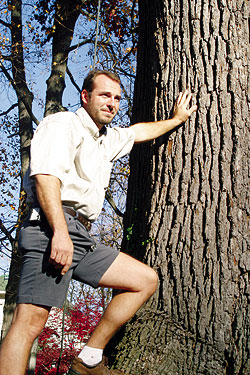 | |
|
Tom Riley can tell you the species and number of every tree on campus.
|
But on this beautiful autumn day in 2003, we’re walking along the east side of Detchon Hall and the Illinois native is talking about trees—the 1,039 trees he feeds, trims, culls, and nurtures as the College’s head groundskeeper and landscaper.
We were able to save this bald cypress—I’m so glad. It’s about 75-100 years old. The contractors wanted to cut it down so they’d have space for the scaffolding while constructing the new science building. I told them, "No way." We had to prune some, which I don’t like to do, but it beats a stump.
The New Testament tells us that God knows us so well that even the hairs on our heads are numbered. At Wabash, so are the trees. They’ve been plotted and mapped by global positioning satellites as part of the College’s master plan, and Riley can tell you the species and number of every one.
If you asked me, ‘Which one’s your favorite?’ I’d say it’s the big white oak out here by the College sign. Montgomery County claims to have the state record white oak; ours is 211 inches around, and it beats the state record by 11 inches. That was the common size of all the trees through here in the early 1800s, when the settlers first came, back when that white oak was just a sapling.
Riley was hired as a grounds- keeper in 1995 and quickly became acquainted with the campus Master Plan and its goals for replacing diseased or dangerous trees on College grounds. In 1998, 40 trees had to be removed from campus. The next fall under Riley’s supervision, 48 were planted.
His duties include the care of the Fuller Arboretum—the grove of trees covering much of the campus intended to display the diversity of trees species in Indiana.
We have a great variety of trees on campus, but we don’t have all 50 of the Indiana tree species. We’re strong on hardwoods, but I would like to make it a complete collection, to bring in more of these under story trees like the box elder and the paw paw, different kinds of dogwoods, and thorn locusts. Last year I purchased native trees from the state of Indiana—wild cherry, redbud, black oak, swamp oak, dogwood, jack pine. We’d like to complete the collection in a way that looks like it’s growing naturally.
But Riley spends much of his time and energy preserving the College’s older trees. That work includes fitting the largest of them with lightning rods!
Sycamore trees get hit by lightning more than any other. Tulip poplar is number two, and oak is number three. It’s all because of water content, and the tulip is also the tallest tree in Indiana, and the sycamore the largest. They’re easy targets.
We need to cable these large sycamores and redo the large oak and attach spikes to the top to protect them—you need one for every 30 feet of canopy. They take the hit and drive it to the ground and out away to a rod in the ground away from the roots.
Riley has a wife and two kids at home, and a nursery at Wabash. He started the nursery when groundwork for the Allen Center displaced bushes he wanted to save. It keeps a host of plants and small trees alive in a small plot in Mud Hollow across from the football and soccer practice field on Will Hays Drive.
Any time they tear down a building or do some sort of construction that threatens a plant, I try to save it and bring it down here. When we need it, we dig it up and plant it in a new place—we did all the landscaping for the Beta House with plants we’d saved here. I got the landscape grasses for Hays Center from here, and over here’s part of what I ordered from the state—dogwoods, ninebark, persimmon trees, and here are some native Indiana prairie grasses.
A year since his treatment for cancer and the day before his most recent CAT scan, Riley finds encouragement among the old sycamores and oaks, still gets ribbed by colleagues for trying to save seem-ingly hopeless specimens (which he often revives!), and relishes the planting of each new tree, as well as the shaping of the arboretum.
I’ve done this ever since I was a kid. I grew up on a farm, big into gardening. I just loved plants. I didn’t expect to be designing landscaping when I hired on here; it’s been a leap of faith for the College—they let me do small projects, at first, and I’ve gotten a lot better at it over the years.
There’s been so much construction going on here, so much disruption of the soil, and it takes a couple years to get the grass looking good, everything back growing again. This fall, though, the campus looks better than it has in years. I’m real happy about the way things are looking.